Hi all! Welcome to my blog! I will be sharing assignments from my May Term in Paris!
Don't wanna be here? Send us removal request.
Text
Entry 5: Religion in Paris
Paris is an extremely interesting and thought provoking city when it comes to religion, and my time here has caused me to do a lot of reflecting when it comes to my own views towards God and the church. Due to the large amounts of religious diversity present in Paris, and the different places of worship that I have visited (both with the class and on my own), I feel as though my time here has really helped me to better understand some of the nuances of religion in France.
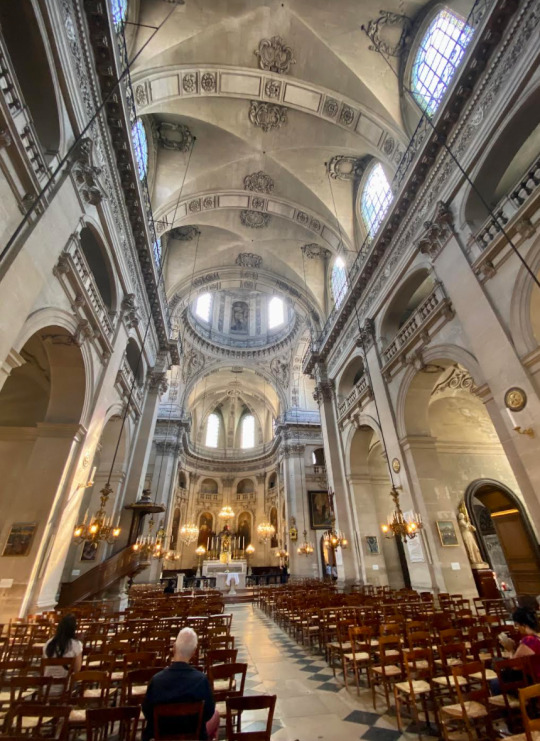
France has such a deep and interesting history with religion and Catholicism, and I feel that you can really see that in the architecture of the city and in the way Parisians treat religion. France was traditionally a very Catholic country, however after the dechristianization of the French revolution, Parisians became less religious. Although Napoleon signed a Concordat with the Vatican to restore the power of the church in France so that he could become the Holy Roman Emperor, the Catholic church never quite returned to its former dominance in France. Eventually, in 1905 a law was passed stipulating the separation of church and state, with the state still owning church property. This allows the French government to maintain them as historical landmarks. Personally, I really felt like the separation of church and state feels more obvious in Paris than it does in the United States. Based on my experience here, I feel as though Parisians are more private with their religion, and mostly keep it to themselves. I haven’t seen people evangelizing in the streets, religious advertisements, or signs outside churches trying to get people to come in. Despite this, France remains a Catholic country, and the church is still a very important part of the history of the nation.
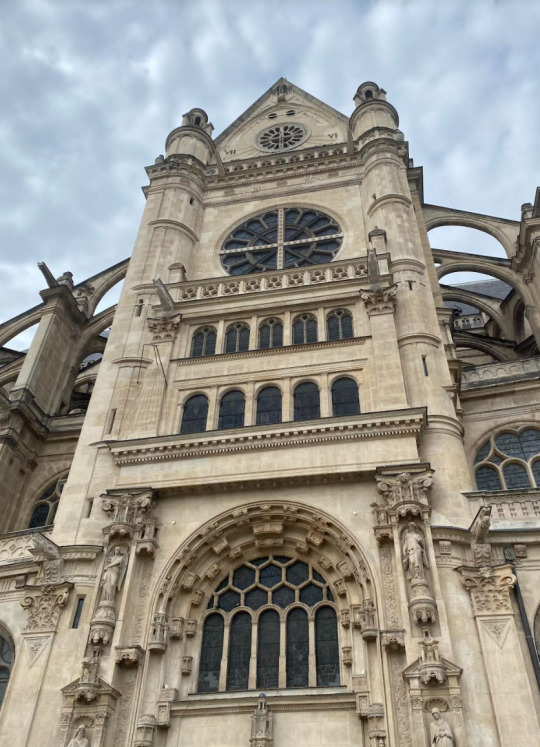
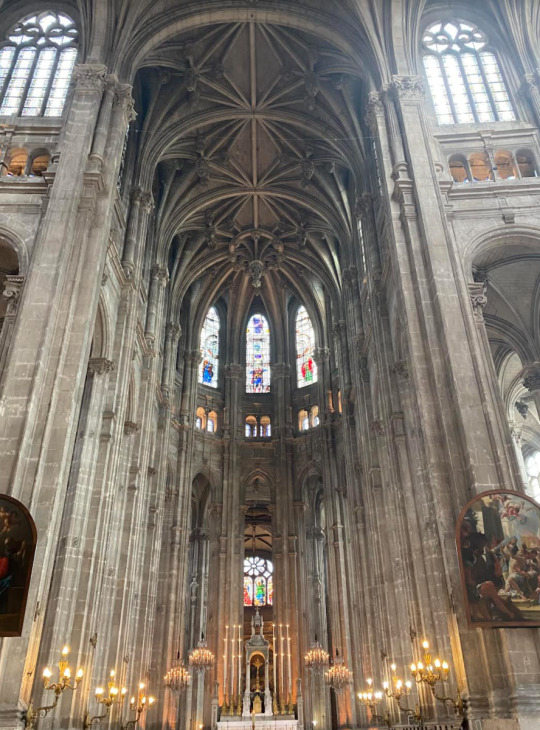
Visiting historic churches and going to a Catholic mass at St. Eustache was very moving for me. I grew up in a household where I was raised in both the Catholic and Presbyterian churches and went to both churches for worship because my Dad was raised in an Irish Catholic family and my Mom is Presbyterian. I ended up being confirmed into the Presbyterian church because my Mom did not like that women did not have a role in the Catholic church, and my Dad has had “enough of the church” after going to Catholic school and going to mass nearly every day as he was growing up. Therefore, going to mass was very emotional for me, and felt a little strange. Due to my youth, I understood everything that was going on, however I felt very out of place. I spent most of the mass reflecting on the beauty of the church and thinking about my relationship with God. Personally, I have been trying to understand my own faith in order to "own it" instead of just listening to exactly what the church says as an institution, so it was very provoking to be in such a massive church.
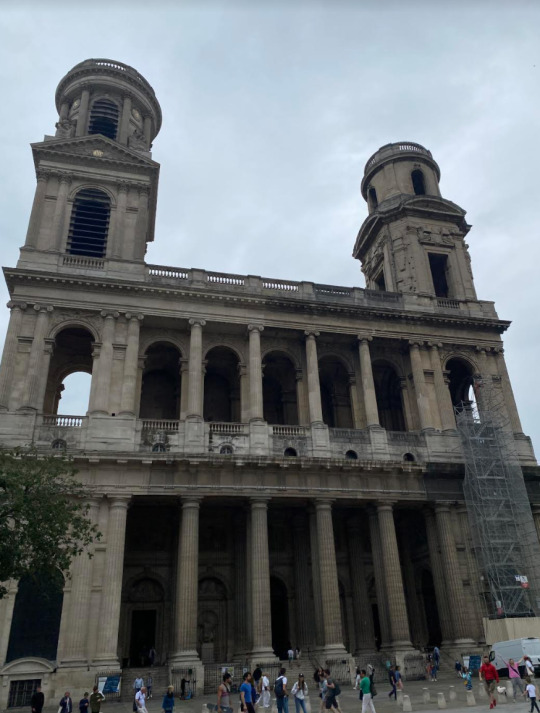
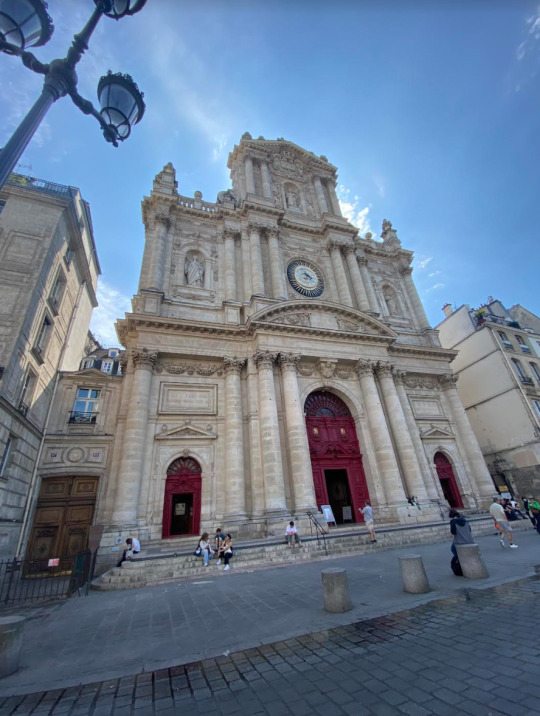
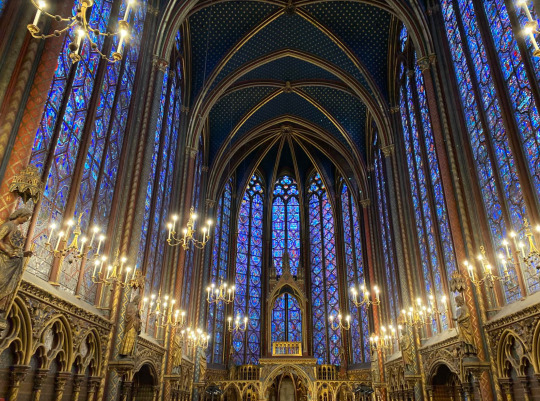
Overall, on this trip I have spent a lot of time visiting current places of Catholic worship both with the class and on my own to see the history, like St Paul St Louis church and Notre Dame, and visiting former places of worship Sainte Chapelle and the Pantheon. This has caused me to reflect a lot on the importance of the church in French history and culture. The Cathedrals are stunning, and they made me reflect and think about how much effort was put into making them, especially at a time when technology was not as advanced. On one hand, it is incredible that people loved God so much that they built these monuments that can be used and enjoyed for generations to honor God. On the other hand, it made me think about how if the effort and money that had been put into making these churches had been spent on spreading God’s message or helping the poor, that would have been closer to what Jesus would have wanted for humanity.
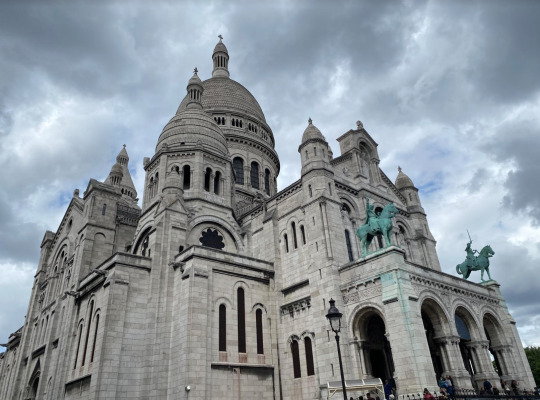
Finally, visiting the Basilica was a very interesting experience for me. While it was beautiful, it made me very uncomfortable how the church was being treated as such a tourist attraction, so it also kind of made my skin crawl a bit. I respect the Church a lot, but the very strict order that is represented there made me reflect on some of the churches actions in the past that I haven't agreed with, and how they have hurt people.
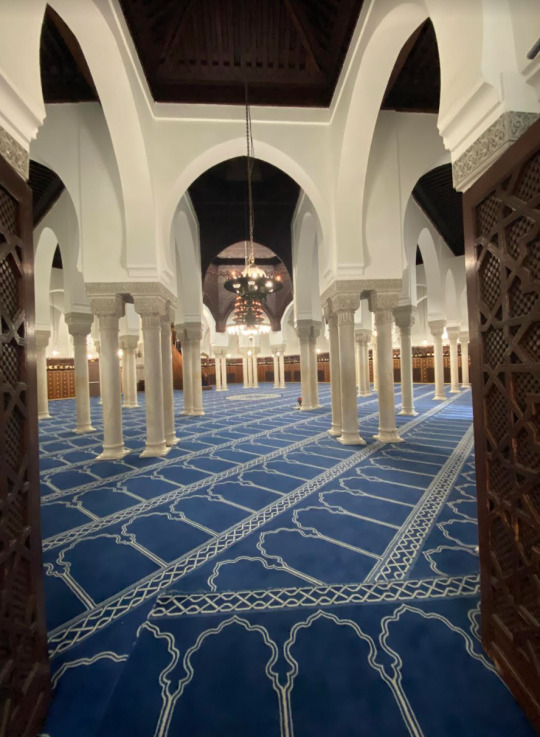
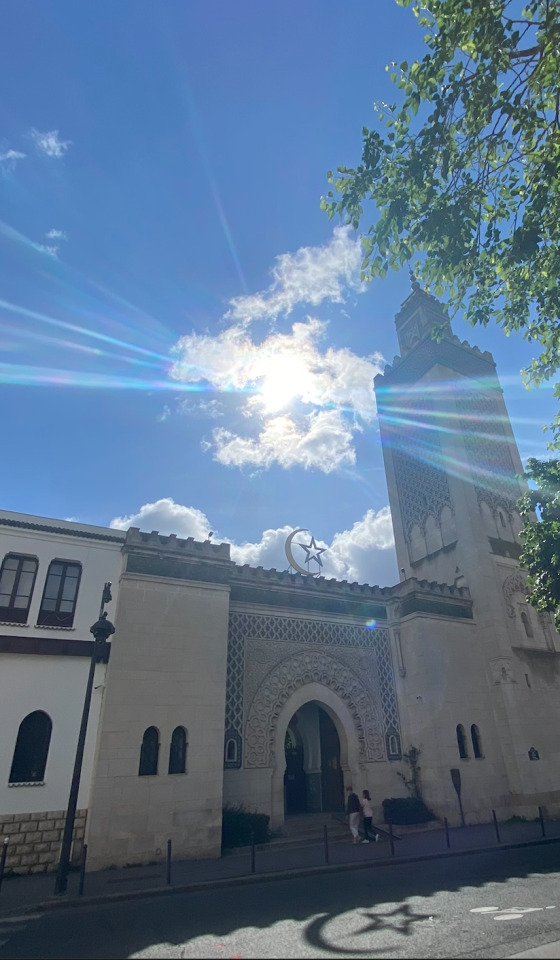
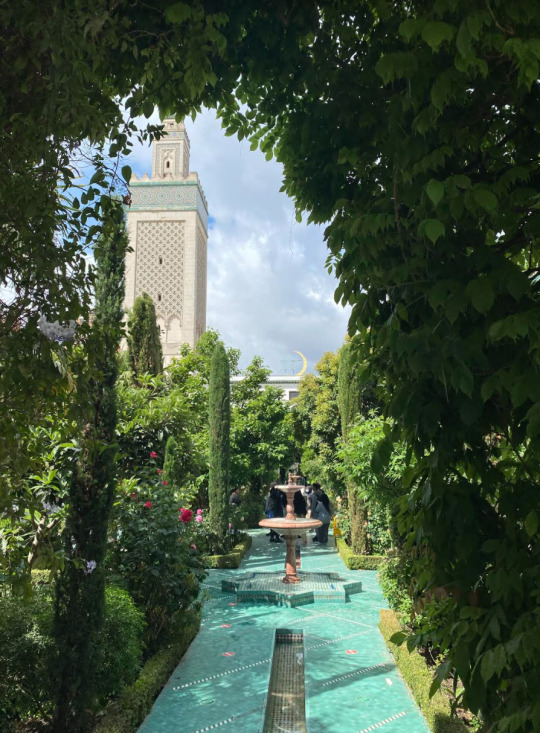
One of the best parts of the trip for me was experiencing the religious diversity of Paris (which isn’t talked about as much) by visiting the mosque. I found it beautiful how the Muslim community focuses on keeping the beauty of the mosque on the inside, and prefers a more modest design. This is very different from the Catholic churches we have visited. I also found it very interesting learning about the Islamic religion because I previously didn’t know as much about it. Learning about the history of the French government with Morocco resulted in no Parisians who are Christian/ tourists being allowed in the prayer room was also fascinating. Additionally, visiting the Immigration Museum and learning about the history of conflicts between the Muslim and Jewish communities was very enlightening for me. It was interesting to learn about how these communities interacted with each other, and how the French Christians treated them differently because they viewed Jewish people as more European. Overall, the religious diversity of the city hasn’t impacted my faith too much, as I did grow up in a very religiously diverse area, and my own household was diverse on its own, so I am used to it. However, I do always think that it is good to have diversity around because it pushes you to edify yourself through your faith and to grow.
0 notes
Text
Entry 3: Museum
Paris is a city that is so rich with history and culture, so it only makes sense that it is full of several interesting and famous museums and monuments. So, when given the opportunity to write about one, I found it difficult to even pick just one! I settled on visiting and reflecting on the Pantheon, because I loved that it was both a monument and a museum, and I was fascinated by the beauty and architecture of the building itself. After seeing the large dome in the Paris skyline all week, I really wanted to check it out for myself!

The Pantheon was constructed under King Louis XV and King Louis XVI (1757-1790) by the architect Jacques-Germain Soufflot. Originally, it was built to be a church that would honor Saint Genevieve (the patron saint of Paris) and house a shrine for her, however during the dechristianization of the French revolution, it was turned into a place to honor the “great men” France who have helped to shape its history. After 1806, Napoleon kept the Pantheon as a crypt but resumed Catholic worship on the upper level. However, when King Louis Philippe took over, he became more cognizant of the fact that he needed to recognize the revolution and the people, so he stopped worship in the building. Then, when Napoleon III took over, he once again resumed Catholic worship inside. Finally, after 1885 when Victor Hugo was laid to rest in the Pantheon, worship inside was stopped and it became just a crypt.

Upon entering the Pantheon, I was shocked at how enormous and beautiful the inner space was. The building itself is a neoclassical style, and is built in the form of a Greco-Roman temple, however it is also slightly reminiscent of some features from gothic cathedrals. The inside of the museum is basically split into the upper level of the main cathedral space, and the lower level containing the crypt. Inside the upper level the walls are lined with different murals depicting several different religious allegories, including Joan of Arc and Saint Denis. Additionally, the room is filled with huge columns and the domes overhead are intricately carved and painted. The upper level is also filled with several different statues and monuments, honoring important French figures and moments in French history. Overall, I experienced the upstairs by just wandering around the wide open space and appreciating the architecture of the building.


My favorite part of the upstairs section is the enormous sculpture of the National Convention by Paul Sicard, honoring the revolution. I loved how huge and detailed it was, and how it really brought your attention to the center of the room.
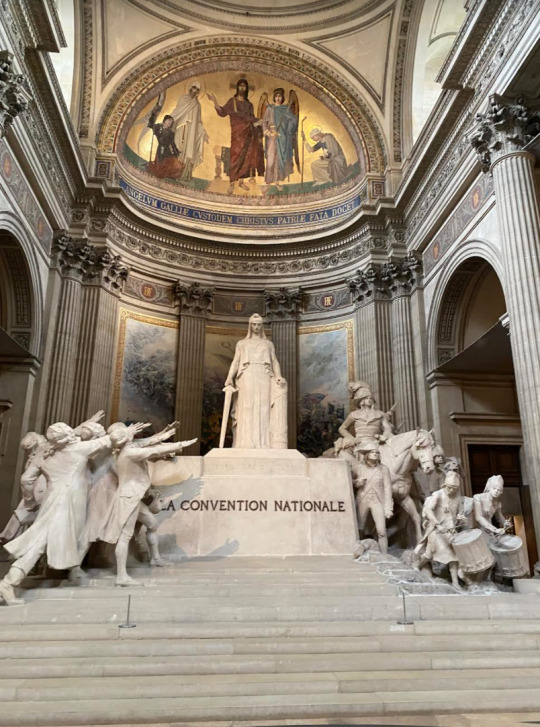
As I proceeded downstairs, I was able to view the crypt portion of the Pantheon. The "basement" area featured a long hallway that split off into smaller rooms containing the graves of important historical figures for France.
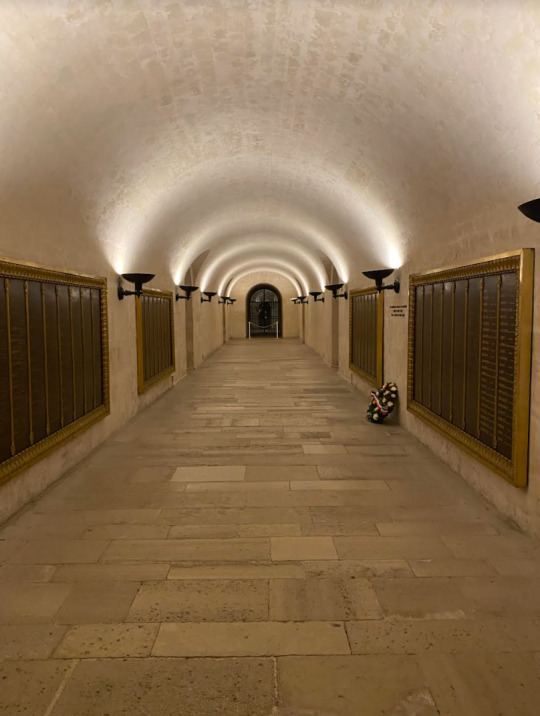
It was so amazing and emotional to be able to view the resting places and monuments to so many historical figures who I have learned about for so long in my history classes. Some of the people that I was able to pay my respects to in the crypt included Voltaire, Victor Hugo, Rosseau, Zola, Braille, and Marie Curie. It was so moving to be able to reflect on what these people have done for France and the world as a whole.
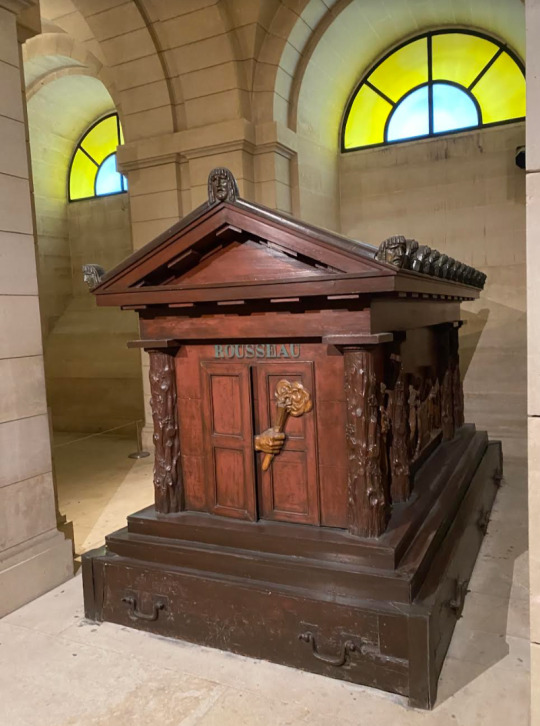


The Pantheon is open everyday from 10am-6pm and cost 11 euros to tour. I really recommend visiting it to reflect on French history and historical figures, and to enjoy the beauty of the building!
Sources:
Paris City Guide
1 note
·
View note
Text
Entry 2: On Pere Lachaise Cemetery
For my second blog assignment, I decided to embark on the metro and visit Pere Lachaise Cemetery on a rainy Sunday morning. Pere Lachaise is the largest cemetery in Paris, and is one of the largest green spaces in the city. It covers 43 hectares, features over 70,000 burial plots, including many famous people and historical figures, and contains several monuments. The cemetery was opened in 1804 to replace unsanitary parish conditions, and to give more burial spaces.
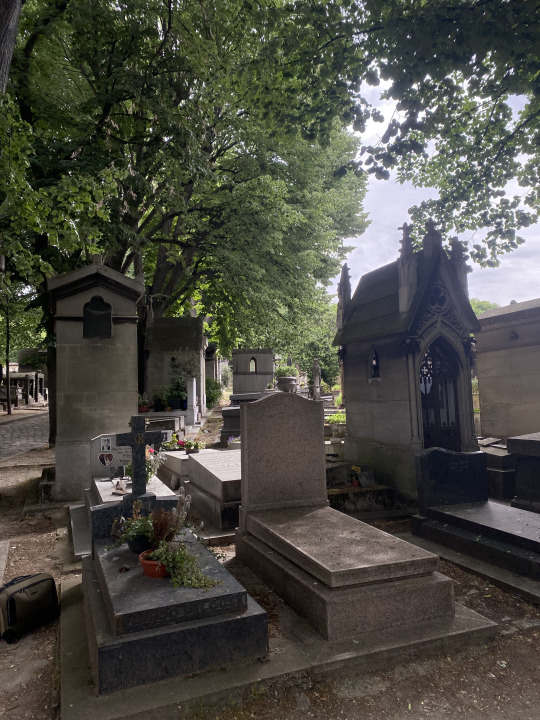
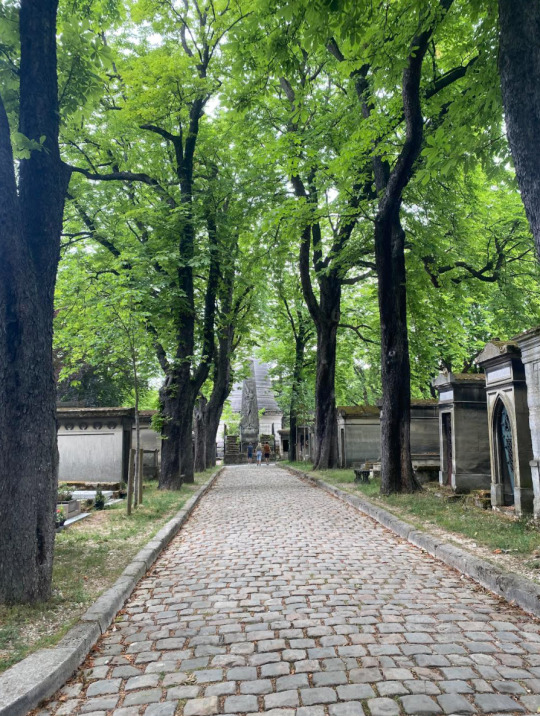
Upon walking into Pere Lachaise, I was immediately struck by how different it felt compared to a cemetery that you could find in the United States. In Pere Lachaise, the cemetery was designed much more as a park, with lots of different sidewalks and places to sit and enjoy the established trees and nature around you, compared to several American cemeteries that I have been to which feel more like a field with graves in them. Another difference was that the graves in Pere Lachaise had a very different look to them compared to American cemeteries, because they were much larger and more ornate. Also, the Parisian graves towered above the ground, and whole families were often buried together. One more difference was that the graves in Pere Lachaise felt more compacted together, versus how they are spread out more in the United States. I also found the memorials in the cemetery to be incredibly beautiful, such as the Monument to the Dead, and the memorials for all the different veterans. This was a great way to show respect for those groups. The chapel and crematorium were also interesting to see, as so many different historical figures and people from all walks of life have passed through there.
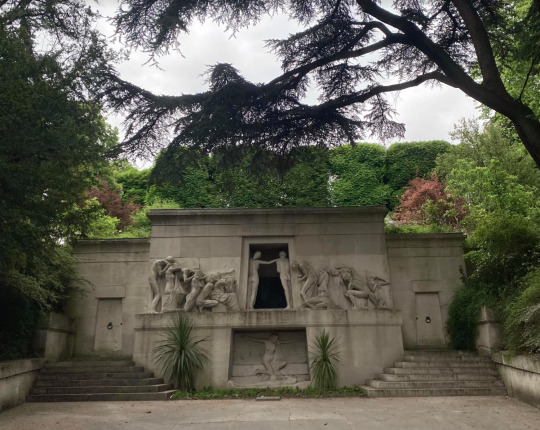
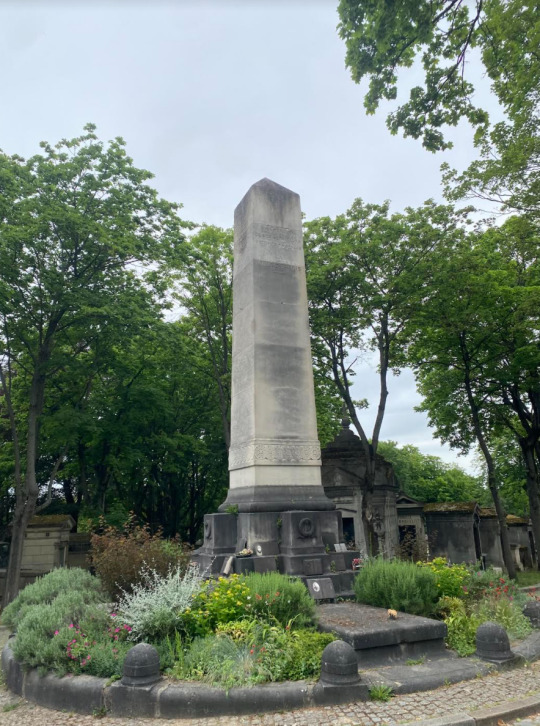
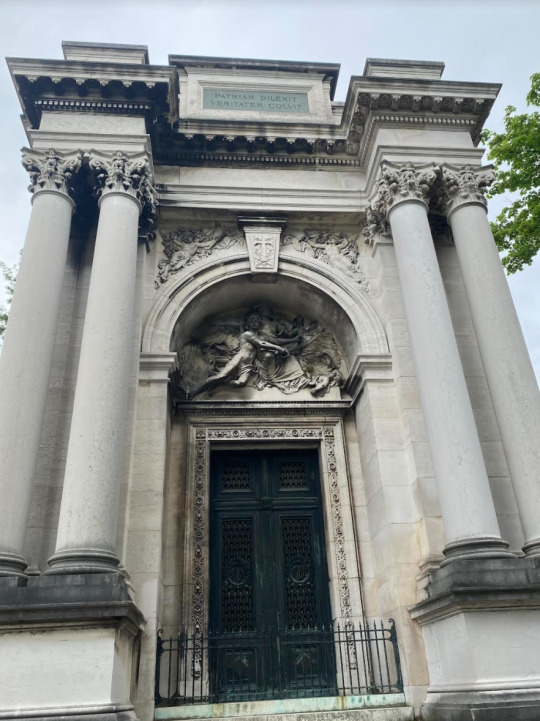
For the most part, I really enjoyed exploring the cemetery. At the beginning of my trip, I felt a little stressed and uneasy, as the expansive cemetery was very difficult to navigate, and it felt a little creepy to me. Also, it felt very strange to me that the resting place of so many people was being treated more like a tourist attraction. However, after a little trial and error (and a lot of studying the map), I was able to figure out the winding pathways and different districts of the cemetery better, and I began to feel a little more comfortable and was able to appreciate the beauty and history more. It was so cool to see all the different types of tombs / graves and how they were unique to each family or person that was buried there, and if they featured different religious depictions or not. For example, Oscar Wilde’s grave contained a book. Another thing that I found super interesting was seeing graves from the early 1800s right next to graves from the 21st century, which really goes to show the deep history of the city of Paris. It was also so cool to see different historical figures buried next to more unknown families as well.
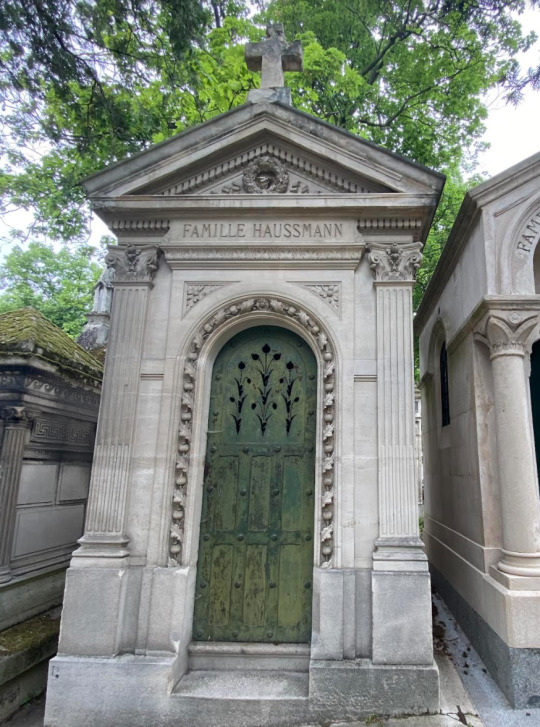
One of the graves that I was most excited to see in my time at Pere Lachaise was the grave of Georges-Eugene Haussmann. Haussmann is responsible for the redesign of Paris. He made the city what it is today by bulldozing large parts of the original city and transforming it to have more wide tree-lined streets, axial perspective, and more modern "Haussmann style" apartments. I was so excited to see his family's because after experiencing the beauty of Paris and learning so much about him in class, I wanted to visit the memorial of the person responsible for much of that. Compared to surrounding graves, I found the Haussmann grave to feel a little more understated, which surprised me for such an important figure, but it was beautiful nonetheless.
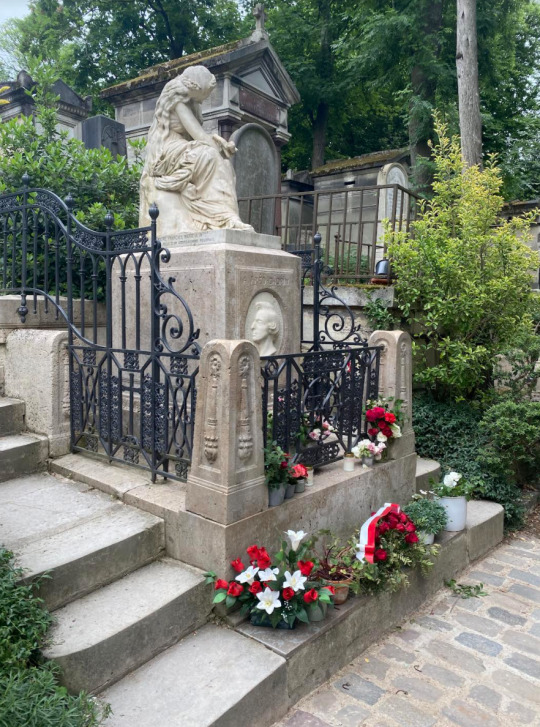
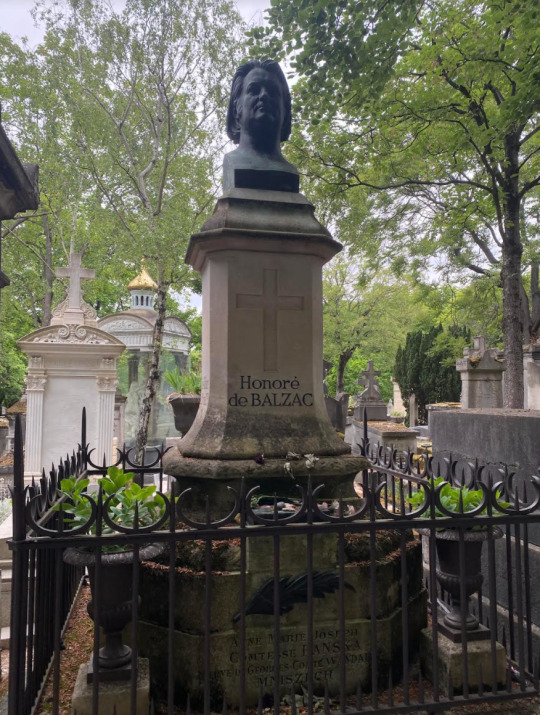
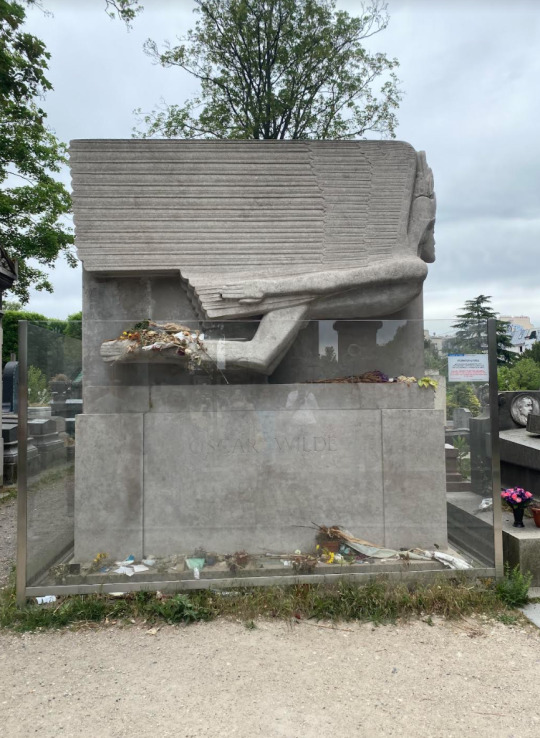
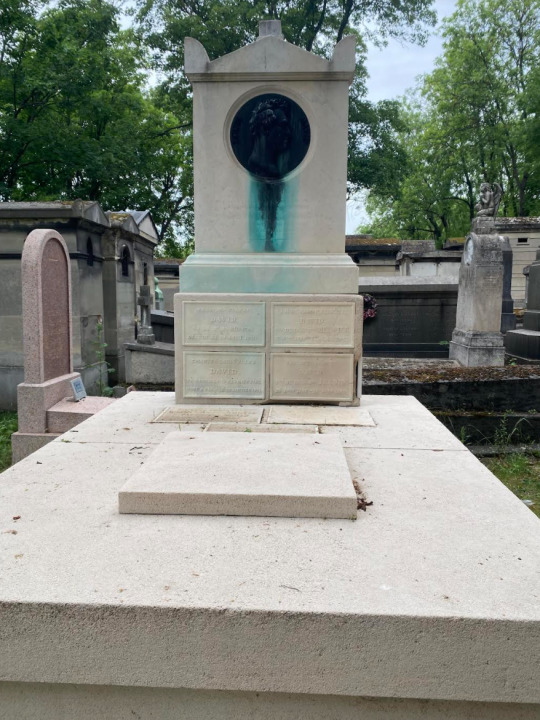
Some more historical graves that was able to visit include Chopin. David, Oscar Wilde, Balzac, and Jim Morrison. I loved being able to honor their memory in this gorgeous historical cemetary!
Sources:
Paris City Guide
0 notes
Text
Entry 1: Place (Square)
Throughout my time in Paris, I have come to really come to enjoy how the city is designed to include so many places, or “squares” in English, to both commemorate the wonderful history of the city, contributing to the beauty of the area, and to serve functional purposes of such as meeting points, little gardens, or crosswalks. After visiting so many different places in my time exploring the city, I had a difficult time choosing which one to write about, however I have chosen to blog about Place de la Bastille because I have visited it and been able to enjoy it several times! I have been able to enjoy the neighborhood of Bastille a couple times, as I have loved visiting the large market that is set up right outside of the square, and the lively area, which is great for grabbing food and seeing the city at night.

Place de la Bastille is located in an area of Paris that is very rich in history, as it is located in the same exact area that the original Bastille Prison was located. The original Bastille was first constructed in 1356, and it served as a prison for enemies of the Ancien Regime. On July 14, 1789, several lower class Parisians/ sans-culottes, and they killed the guards and freed the prisoners. The storming of the Bastille represented such a key point in the French Revolution because it was the first time that the commoners were actively getting involved, and taking down the Bastille itself meant doing away with a symbol of tyranny. At one point during the revolution, a guillotine was even installed in the square. Today, the main monument in the center of the square is referred to as the Colonne de Juillet, or the July Column. It was built in 1831, but the square itself was inaugurated by Louis Phillipe in 1840.

Whether it is day or night, the July Column at the center of the square is always unmissable due to how tall it stands, and how it is illuminated. The monument itself features a large pillar with a golden angel on top and commemorates the 1830 revolution removing Charles X. The angel on the top represents the “angel of liberty”, who herself represents the “spirit of freedom”.




In modern Parisian culture, the Place de la Bastille mostly represents a traffic circle, as it is surrounded by busy roads. However, there are some benches and cobblestone surrounding the main monument, so you can find some people sitting around enjoying it or using it as a meeting place. Additionally, the Place de la Bastille represents the starting point for the bustling Bastille Market, so it does draw several people.

Overall, I really have enjoyed my visits to Place de la Bastille. I have enjoyed using it as a meeting place and appreciating the beauty of the monument/ the history it represents. My favorite visit to the Place de la Bastille was enjoying some falafel from a nearby market stand on the benches surrounding the July Column!
Sources:
Paris City Guide
0 notes
Text
Final Exam
For our final exam, Dr Kraus and Dr Janes split us up into groups and sent us out on scavenger hunt of Paris! We were given a list of nine different landmarks all around the city, and five and a half hours to find them all together. The purpose of the exam was to show that we could successfully navigate mass transit and to find historically and culturally significant landmarks. The only rule of the exam was "no using Ubers or taxis"! Our group (Zoe, Madai, Abby, and Maddy), left from the Jardins des Tuileries at 12:30 pm, and headed straight to the allegorical statue of Brest in the Place de la Concorde because it was so close to the Musee de l'Orangerie where we had spent our morning.

The Allegorical statue of the Brest in the Place de la Concorde was fun to find. The place de la Concorde is one of the largest squares in Paris. All around the border of Place de la Concorde are eight different allegorical statues representing the eight cities of Paris in an octagonal shape. We noticed that there were similar statues surrounding the roundabout but we were able to find it quite easily! We also saw that there were doors that were open in all the statues and we were very curious where the doors led. Fun western piano music played as we followed the stairs to an underground parking garage. It was not what any of us were expecting but it was quite an interesting place to find. After some research, we found that “these sentry boxes, which bear the names of rivers, marked the limits of the old ditches twenty meters wide which surrounded the square. They then ordered bridges which made it possible to cross the ditches and served as two-storey dwellings. A spiral staircase then made it possible to reach the ground floor. The statues were built by Hirtoff in 1838 on each of the sentry boxes. The ditches were filled in in 1853. Two of the sentry boxes provide access to an underground car park and the others are used by municipal services to store their cleaning utensils" (Source 1). The statue itself was made by Jean-Pierre Cortot in 1836, and really adds to the historical significance of the square.

After walking through the 8e, we decided to take the metro over to the 10e to find more of our spots, since it was on the way to the 20e. Also, we knew from experience that we would be able to find a representation of Marianne at the Place de la République right as we got off the metro stop. Marianne is a French symbol that represents the French Republic and "liberty, equality, and fraternity". The statue itself in contains a bronze casting of Marianne, made in 1880, and surrounding it are several bas reliefs depicting important stages of the French Revolution, such as the "Oath of the Tennis Court" painted by David and the storming of the Bastille. The square was actually completely redeveloped and unveiled in June of 2013 in order to give more room to pedestrians. Since then, the statue has become a meeting place for people to show support after terrorist attacks, or to protest, continuing the revolutionary spirit that inspired the statue. Although the area did seem a little more "touristy" there were still several Parasians hanging out around the square, and the surrounding region was bustling with restaurants and stores.

After sitting down to enjoy some lunch and plan out the order for the rest of our scavenger hunt, we visited the Passerelle Bichat, a pedestrian bridge going over a small area of water, the Saint Martin Canal, in the 10th District in Paris. The bridges were built between 1860 and 1890, all of them after the creation of the canal in 1825. It was a gorgeous view once we reached the top, as you were able to look over the water as well as nearby cafes and stores. One thing that stuck out to all of us was that most of the people in the area and using the space were Parisians, which was really cool to see since there is a large tourist spot nearby.

After the bridge, we walked over to the nearest metro stop, and took the train all the way out to the 20e to visit the Parc de Belleville. The park itself was more recently created, being completed in 1988, however before that it was the site of the Belleville Hill, which was used for agriculture, and later a gypsum quarry. The park was created in an effort to "clean up" the 20e, and was created at the same time most of the modern buildings in the area were. Inside the park, we were shocked at how expansive it was, and how much greenery there was. All the established trees made it feel like you had stepped into a forest even though you were in the middle of the city! After climbing up all the stairs and to the top of the 30m high terrace, we were able to enjoy a breathtaking view of Paris. Being able to see all of the buildings and the Eiffel Tower so clearly was incredible, and it was so cool to be able to experience that alongside the nature of the park. At the top of the terrace there was a cute little market and some street art, which we found to be quite beautiful. It showed a wide range of political commentary, humorous content, social justice movements, and more. We even found another representation of Marianne!

Next, we took the metro to 12e to photograph the entrance to the Train Bleu restaurant in Gare de Lyon, a major train station. Getting off the metro to the Gare de Lyon train station was very easy. The architecture reminds us of the impressionist paintings that show the progression of modern life and the importance of the train. The architecture is very recognizable and there are many stores when you enter. But, You do not expect to see this amazing restaurant. It is hidden from the rest but when you enter the restaurant you are no longer looking at a train station but a beautifully decorated space. Gold and ceiling paintings are everywhere and it reminds us of the Opera when we walked the luxury halls. Each ornate dining room is themed to represent cities and regions of France and they are decorated with 41 paintings by some of the most popular artists of that time.

After finishing the first half of the hunt, we took the metro over to the 5e to knock out the rest of our stops, which all happened to be in the same neighborhood. The first place that we went to was the Ménagerie (zoo) in the Jardin des Plantes. This was a gorgeous park that was bustling with people and had paths leading to a variety of things such as the bibliothéque and the zoo, which we were asked to take a picture of. Afterwards we found out that originally it mostly housed animals that were from the royal zoo. It was originally founded in 1794 and is one of the oldest zoos in the world. A fun fact that we found to be super interesting was that during the Siege of Paris in 1870, starving Parisians had to eat zoo animals to survive. We thought that this was one of the most interesting places that we visited and would love to come back and actually take time and visit the zoo!

Next, we decided to walk through the 5e to find the mural by Pierre Alechinsky, which illustrates Yves Bonnefoy;s poem " L'arbre des Rues". This stop was a little harder to find, because it was tucked behind the wall of a building. The mural itself was a beautiful white and blue piece that pictured a tree surrounded by a variety of nature. On the wall it also portrayed the poem itself. After researching this piece, we became more interested in the work itself. The tree, which represents the need to protect nature especially from the growth of urbanization, is surrounded by what we now know to be Predellas of medieval altarpieces. This relates to the poem's meaning of protecting nature and how it protect us back.This shows us how much we have an impact on our environment.

After appreciating the artwork, we went off to find the front of the rue Cardinal Lemoine. The street is named after cardinal Jean Lemoine, and because it is built in the area of a University that used to exist in 1302, that had the same name. The street itself felt very "Parisian", and it was filled with several cute cafes, shops, and a hotel. After strolling around, we found the front of the street to be our favorite part. It included a little square and fountain, and was surrounded by little restaurants and gelato shops. It was nice to see so many Parisians out enjoying the weather and surrounding area.

We finished up our journey by taking the metro to another stop in the 5e, the Musée de Cluny, where we were tasked with catching a glimpse of the ruins of the Roman baths, which can be seen from the Blvd St. Michelle. There is a lot of history behind the baths, such as their creation in either the first or second centuries, being fairly well conserved during the Middle Ages, and then the labeling of the area as a “historical monument” in the 19th century and further conserved within the museum. It was a crazy sight to see because the baths looked to be in amazing condition for how old they are. It was even cooler to see this sight with all of the newer buildings surrounding it, showing how quickly life can change and eras come and go.

Finally, we finished up our day by metroing back to the Hotel Citadines, where we rested for a little bit, before heading over to Dr Kraus and Dr Janes's apartment for some desserts and snacks with the class. Best final "exam" ever!
Sources:
0 notes
Text
Entry 4: Jardin (Garden)
For my first blog assignment, I decided to visit the Jardin des Tuileries. I was lucky enough to be able to visit this garden and appreciate its beauty on both May 18th and 20th! It is located in the 1st arrondissement of Paris between the Louvre and the Place de la Concorde, and contains two fountains/pools, an expanse of greenery, several sculptures, and unmatched views of the surrounding historical architecture. You can even sneak a peek of the top of the Eiffel Tower while sitting by the pools!
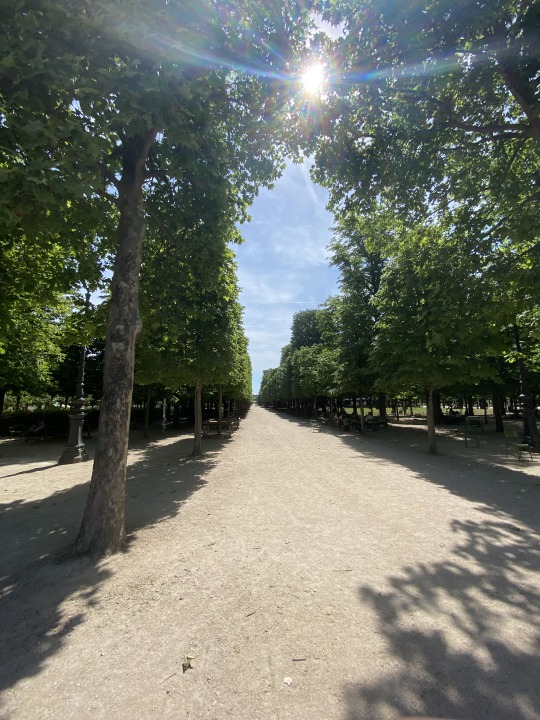
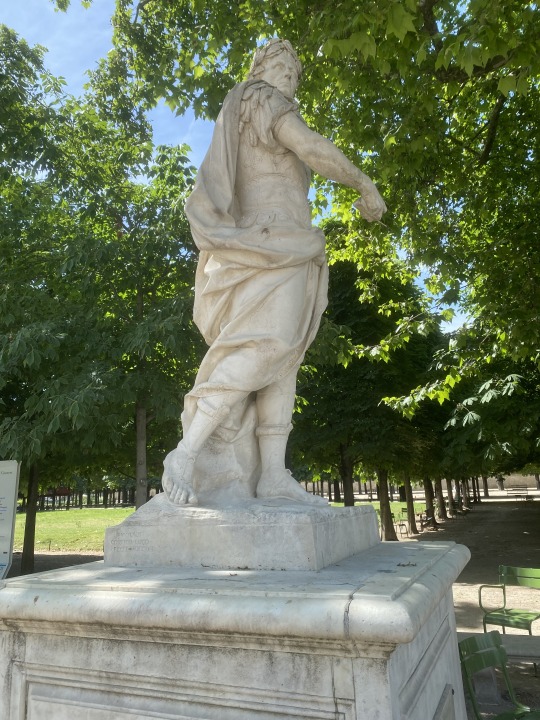
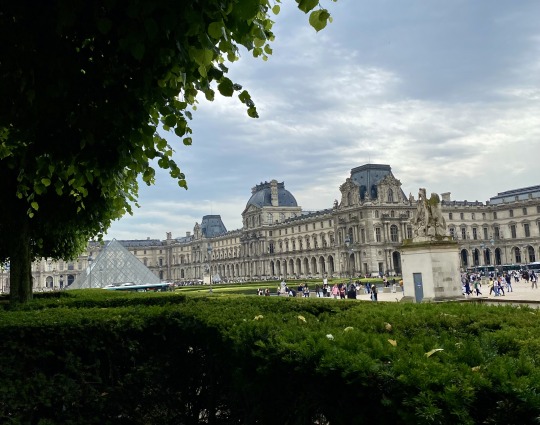
The garden was originally constructed in 1564 when Queen Catherine de Medici built the Tuileries Palace. She commissioned an Italian architect, Bernard de Carnesse, to build the garden as an Italian Renaissance garden. It was given its name because the area has been occupied by tile making factories since the 1200s, and tulie means tile in French. In 1664, under King Louis XIV, Colbert had the architect André le Nôtre redesign the garden to be a true French garden and to be viewed above from a terrace, replacing some of the garden with the pools and removing the central street. Originally, the garden was reserved only for the royal family, however during the French revolution when the royal family was housed at the Tuileries Palace, the garden was reserved for them in the morning , and the public in the afternoon. Nowadays, the garden is completely open to the public. My favorite part of the garden is the axial perspective that you get with several of the major Parisian historical monuments going right down the center, which is highlighted by Haussmann’s wide boulevard at the end. It’s so cool to be able to see the Louvre, Arc du Carrousel, the garden pools, the Luxor Obelisk, the Arc de Triomphe, and the Place de la Concorde all in one line!

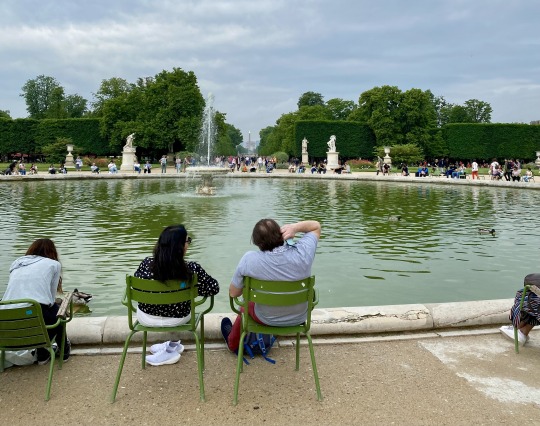
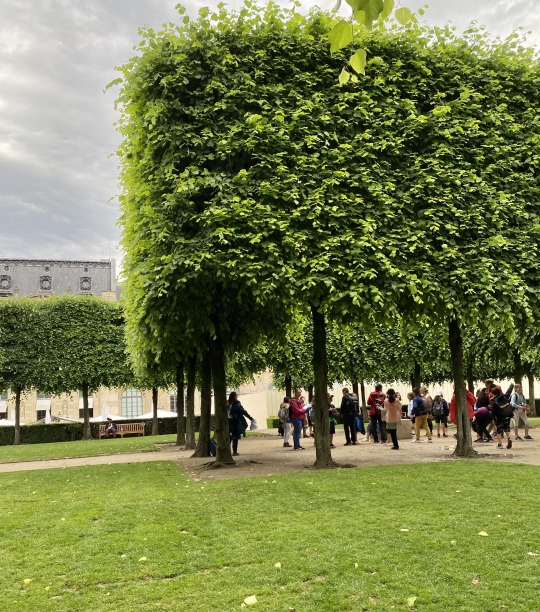
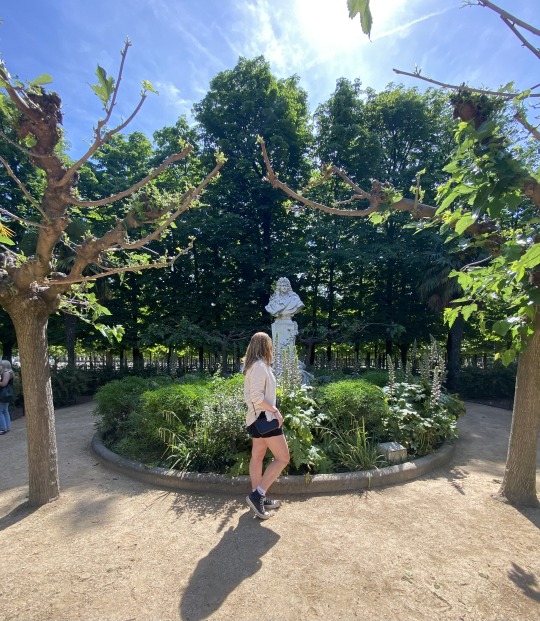
Today, this garden has transformed from only serving royalty and nobility, to truly being a garden meant fo the public to enjoy. As we walked through the garden, I saw many a type of people out enjoying the weather and beauty of the parks. The garden was filed with school children playing, tourists of the Louvre, Parisians reading or sitting in the sun, couples spending time together, people exercising, people walking their pets, and people having a bite to eat. The garden includes several chairs and benches for people to be able to sit outside and enjoy it. Additionally, it includes a gelato and coffee/pasty/sandwich stand to cater even more to the public. There is even a little trampoline area and park set up for the smaller children!
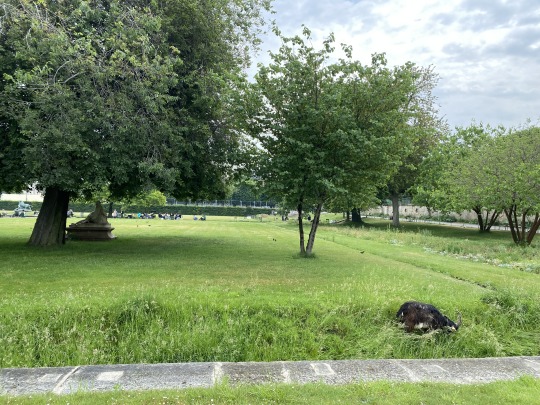
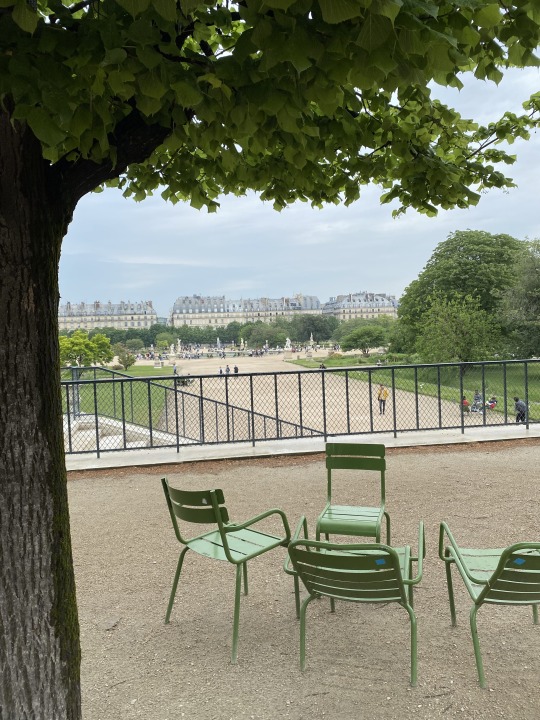
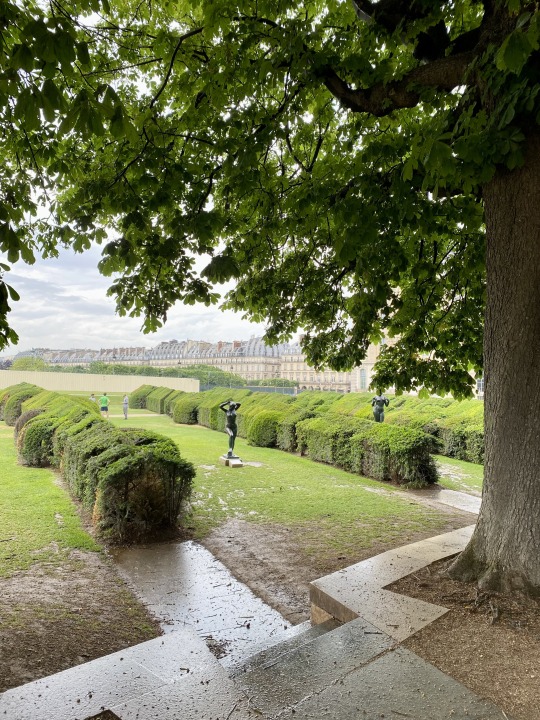
Overall, I when I experienced this garden, I really loved it. I spent my time walking around and viewing the sculptures, reading my book, looking on at the surrounding Arc du Carrousel and Louvre, and doing the most Parisian activity- people watching! I even saw a goat eating the grass! The design of it being a very wide open space and looking on at so many historical landmarks contributes to it being a public space because it draws people in and makes them want to come enjoy it. Its wide open design also makes it feel like a break from the surrounding city. Visually, I loved how the greenery adds to the beauty of the city. I experienced it as a public space because so many different types of people out enjoying it, and sitting in the chairs by the pools people watching made me feel like a true Parisian.
2 notes
·
View notes